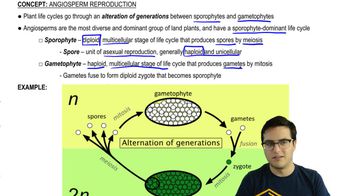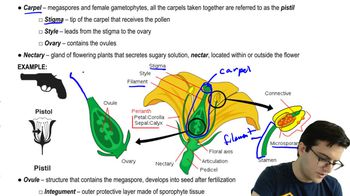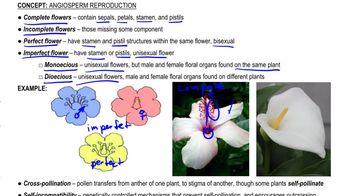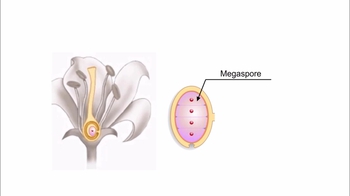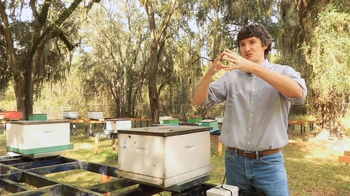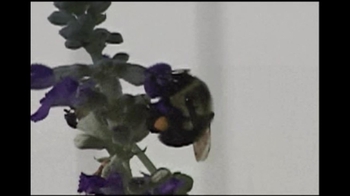Table of contents
- 1. Introduction to Biology2h 42m
- 2. Chemistry3h 40m
- 3. Water1h 26m
- 4. Biomolecules2h 23m
- 5. Cell Components2h 26m
- 6. The Membrane2h 31m
- 7. Energy and Metabolism2h 0m
- 8. Respiration2h 40m
- 9. Photosynthesis2h 49m
- 10. Cell Signaling59m
- 11. Cell Division2h 47m
- 12. Meiosis2h 0m
- 13. Mendelian Genetics4h 44m
- Introduction to Mendel's Experiments7m
- Genotype vs. Phenotype17m
- Punnett Squares13m
- Mendel's Experiments26m
- Mendel's Laws18m
- Monohybrid Crosses19m
- Test Crosses14m
- Dihybrid Crosses20m
- Punnett Square Probability26m
- Incomplete Dominance vs. Codominance20m
- Epistasis7m
- Non-Mendelian Genetics12m
- Pedigrees6m
- Autosomal Inheritance21m
- Sex-Linked Inheritance43m
- X-Inactivation9m
- 14. DNA Synthesis2h 27m
- 15. Gene Expression3h 20m
- 16. Regulation of Expression3h 31m
- Introduction to Regulation of Gene Expression13m
- Prokaryotic Gene Regulation via Operons27m
- The Lac Operon21m
- Glucose's Impact on Lac Operon25m
- The Trp Operon20m
- Review of the Lac Operon & Trp Operon11m
- Introduction to Eukaryotic Gene Regulation9m
- Eukaryotic Chromatin Modifications16m
- Eukaryotic Transcriptional Control22m
- Eukaryotic Post-Transcriptional Regulation28m
- Eukaryotic Post-Translational Regulation13m
- 17. Viruses37m
- 18. Biotechnology2h 58m
- 19. Genomics17m
- 20. Development1h 5m
- 21. Evolution3h 1m
- 22. Evolution of Populations3h 52m
- 23. Speciation1h 37m
- 24. History of Life on Earth2h 6m
- 25. Phylogeny2h 31m
- 26. Prokaryotes4h 59m
- 27. Protists1h 12m
- 28. Plants1h 22m
- 29. Fungi36m
- 30. Overview of Animals34m
- 31. Invertebrates1h 2m
- 32. Vertebrates50m
- 33. Plant Anatomy1h 3m
- 34. Vascular Plant Transport1h 2m
- 35. Soil37m
- 36. Plant Reproduction47m
- 37. Plant Sensation and Response1h 9m
- 38. Animal Form and Function1h 19m
- 39. Digestive System1h 10m
- 40. Circulatory System1h 57m
- 41. Immune System1h 12m
- 42. Osmoregulation and Excretion50m
- 43. Endocrine System1h 4m
- 44. Animal Reproduction1h 2m
- 45. Nervous System1h 55m
- 46. Sensory Systems46m
- 47. Muscle Systems23m
- 48. Ecology3h 11m
- Introduction to Ecology20m
- Biogeography14m
- Earth's Climate Patterns50m
- Introduction to Terrestrial Biomes10m
- Terrestrial Biomes: Near Equator13m
- Terrestrial Biomes: Temperate Regions10m
- Terrestrial Biomes: Northern Regions15m
- Introduction to Aquatic Biomes27m
- Freshwater Aquatic Biomes14m
- Marine Aquatic Biomes13m
- 49. Animal Behavior28m
- 50. Population Ecology3h 41m
- Introduction to Population Ecology28m
- Population Sampling Methods23m
- Life History12m
- Population Demography17m
- Factors Limiting Population Growth14m
- Introduction to Population Growth Models22m
- Linear Population Growth6m
- Exponential Population Growth29m
- Logistic Population Growth32m
- r/K Selection10m
- The Human Population22m
- 51. Community Ecology2h 46m
- Introduction to Community Ecology2m
- Introduction to Community Interactions9m
- Community Interactions: Competition (-/-)38m
- Community Interactions: Exploitation (+/-)23m
- Community Interactions: Mutualism (+/+) & Commensalism (+/0)9m
- Community Structure35m
- Community Dynamics26m
- Geographic Impact on Communities21m
- 52. Ecosystems2h 36m
- 53. Conservation Biology24m
36. Plant Reproduction
Flowers
Problem 2`
Textbook Question
Double fertilization means that:
a. Flowers must be pollinated twice to yield fruits and seeds
b. Every egg must receive two sperm to produce an embryo
c. One sperm is needed to fertilize the egg, and a second sperm is needed to fertilize the polar nuclei
d. Every sperm has two nuclei
 Verified step by step guidance
Verified step by step guidance1
Understand the concept of double fertilization, which is a unique process in angiosperms (flowering plants) where two fertilization events occur within the ovule.
Recognize that in double fertilization, one sperm cell fertilizes the egg cell, forming a diploid zygote, which will develop into the embryo.
Identify that the second sperm cell fuses with the two polar nuclei in the central cell of the ovule, forming a triploid cell, which will develop into the endosperm, a tissue that provides nourishment to the developing embryo.
Eliminate options that do not align with the process of double fertilization: Option a is incorrect because pollination is separate from fertilization. Option b is incorrect because each egg is fertilized by one sperm. Option d is incorrect because sperm cells do not have two nuclei.
Conclude that the correct answer is option c, as it accurately describes the two distinct fertilization events in double fertilization: one sperm fertilizes the egg, and the other fertilizes the polar nuclei.
 Verified video answer for a similar problem:
Verified video answer for a similar problem:This video solution was recommended by our tutors as helpful for the problem above
Video duration:
2mPlay a video:
Was this helpful?
Key Concepts
Here are the essential concepts you must grasp in order to answer the question correctly.
Double Fertilization
Double fertilization is a unique process in angiosperms where two sperm cells are involved in fertilization. One sperm fertilizes the egg cell, forming a zygote, while the other sperm fuses with two polar nuclei to form the triploid endosperm, which nourishes the developing embryo. This process ensures efficient use of resources for seed development.
Recommended video:
Guided course

Double Fertilization
Role of Sperm Cells in Double Fertilization
In double fertilization, two sperm cells play distinct roles. The first sperm cell fertilizes the egg cell, resulting in the formation of a diploid zygote, which will develop into the embryo. The second sperm cell fuses with the two polar nuclei in the central cell of the ovule, forming a triploid cell that develops into the endosperm, providing nutrition to the growing embryo.
Recommended video:
Guided course

Double Fertilization
Polar Nuclei
Polar nuclei are two haploid nuclei located in the central cell of the ovule in flowering plants. During double fertilization, one of the sperm cells fuses with these polar nuclei to form a triploid cell, which becomes the endosperm. The endosperm is crucial for providing nutrients to the developing embryo, supporting its growth and development within the seed.
Recommended video:
Guided course

Polar Covalent Bonds

 5:18m
5:18mWatch next
Master Alteration of Generations with a bite sized video explanation from Jason
Start learningRelated Videos
Related Practice

